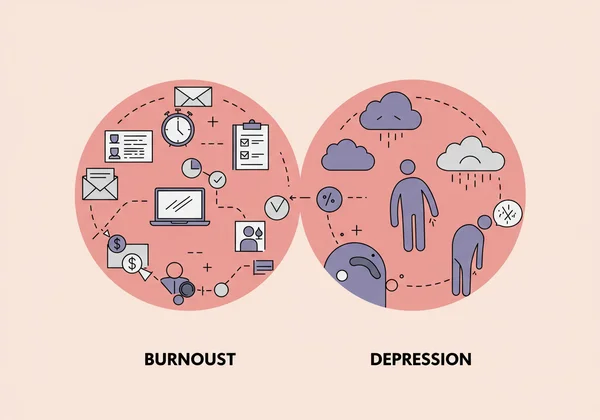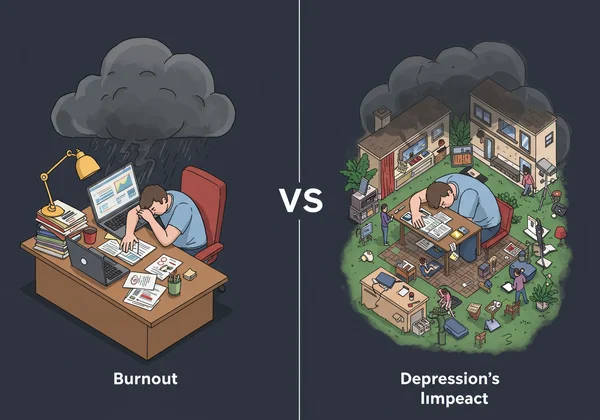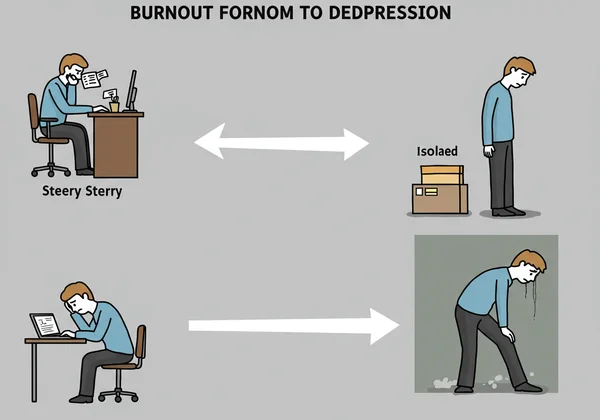Burnout vs. Depression: Key Differences & How Our Burnout Test Can Help
Feeling overwhelmed, drained, and disconnected? It's a heavy burden to carry, and it's easy to confuse the deep exhaustion of burnout with the persistent sadness of depression. While they share symptoms, understanding the crucial distinctions between these two conditions is the first step toward finding the right path to recovery. This guide will clarify the core differences in the burnout vs. depression debate, empowering you to identify your experience more accurately. Am I depressed or burnt out? By the end of this article, you'll have a clearer answer and know the next steps to take.
The journey to understanding your mental state begins with self-assessment. A great starting point for clarifying work-related stress is to take our free burnout test, a science-backed tool designed to provide instant insights into your professional well-being.

Understanding Burnout & Depression: Defining Each Condition
Let's start by clearly defining burnout and depression for an effective comparison. Understanding their distinct origins and scope is crucial. Burnout is a response to a specific environment, while depression is a broader mood disorder that affects all aspects of life.
What is Occupational Burnout?
Occupational burnout is a state of emotional, physical, and mental exhaustion caused by prolonged or excessive stress specifically related to your job. The World Health Organization (WHO) classifies it as an "occupational phenomenon," not a medical condition. It's characterized by three main dimensions:
- Exhaustion: Feeling depleted of energy and emotionally drained.
- Cynicism or Negativity: Feeling detached from your job and experiencing increased mental distance from your professional responsibilities.
- Reduced Professional Efficacy: A sense of incompetence and a lack of achievement at work.
Crucially, burnout is tied to your work context. If you remove the source of the stress—for example, by taking a long vacation or changing jobs—the symptoms of burnout often begin to alleviate.
What is Clinical Depression?
Clinical depression, or Major Depressive Disorder (MDD), is a serious mood disorder that affects how you feel, think, and handle daily activities. Unlike burnout, depression is pervasive. Its symptoms cast a shadow over all areas of your life, not just your work. Feelings of sadness, hopelessness, and a loss of interest are not confined to the office; they follow you home, impact your relationships, and diminish your enjoyment of hobbies.
Depression is a diagnosable medical condition that requires a professional evaluation. It stems from a complex mix of genetic, biological, environmental, and psychological factors and typically requires a structured treatment plan from a healthcare provider.
Key Differences: Burnout and Depression Symptoms
While symptoms like fatigue and low mood can overlap, the burnout and depression symptoms manifest differently. Understanding these nuances can help you pinpoint the source of your distress. Let's break down the key areas of distinction.

Emotional Exhaustion vs. Persistent Sadness
While both conditions involve difficult emotions, their nature differs. Burnout is primarily defined by emotional exhaustion and frustration related to work. You might feel irritable, anxious about deadlines, and emotionally numb toward your colleagues or tasks. However, you may still find joy and energy in non-work activities.
Depression, on the other hand, is characterized by a persistent feeling of sadness, emptiness, or hopelessness that is global. It’s not just about work; it’s about everything. This low mood is consistent and doesn't lift, even when engaging in activities you once loved.
Cynicism & Detachment vs. Anhedonia & Loss of Interest
Burnout often leads to cynicism and a sense of detachment from your job. You might start to feel negatively about your role, your company, and your industry. This is a coping mechanism to create distance from the overwhelming demands of your work. You're trying to protect yourself from further emotional investment.
Depression involves a more profound and widespread anhedonia, which is the inability to feel pleasure. It's not just that you've lost interest in your job; you've lost interest in hobbies, socializing with friends, and life in general. This loss of interest is pervasive and a core symptom of a depressive episode. For an initial look at your work-related feelings, an online burnout assessment can offer valuable clarity.
Work-Related Focus vs. Pervasive Life Impact
This is arguably the clearest difference. The negative feelings associated with burnout are almost exclusively centered on your job. You dread Monday mornings, count down the minutes until you can leave, and feel a sense of relief on weekends or vacations. The source of the problem has a specific work-related focus.
Depression’s impact is pervasive. It doesn't matter if it's a workday or a holiday; the feelings of worthlessness, guilt, and sadness persist. It affects your appetite, sleep patterns, relationships, and self-esteem across all contexts. If these feelings are widespread, seeking professional help is essential.
Physical Manifestations: What Does Burnout Fatigue Feel Like?
Many people ask, What does burnout fatigue feel like? It's a profound exhaustion that sleep doesn't seem to fix. You might feel physically drained, experience headaches, or have trouble concentrating at work. Your body feels heavy, but this is often a direct result of chronic stress from your job.
Depression can also cause severe fatigue, but it is often accompanied by other physical symptoms like unexplained aches and pains, significant changes in weight (either loss or gain), and psychomotor changes (moving or speaking more slowly). The fatigue in depression is tied to the overall low energy and motivation that permeates every aspect of life.
When Symptoms Overlap: Is It Burnout or Am I Depressed?
It's understandable to feel confused, especially since chronic, unmanaged burnout can be a significant risk factor for developing depression. This is why addressing feelings of workplace stress early on is so important. Using a tool like a Job Burnout Test can be a proactive first step.
Can Burnout Lead to Depression? Understanding the Progression
Yes, it can. If the conditions causing burnout are not addressed, the chronic stress can deplete your emotional and physical resources. The feelings of helplessness and exhaustion can spill over from your work life into your personal life, potentially triggering a depressive episode. The cynicism from burnout can morph into the hopelessness of depression.
Think of it as a continuum. Burnout is a state of depletion tied to a specific stressor (work). If that stressor isn't managed, it can exhaust your coping mechanisms, making you more vulnerable to a broader mental health condition like depression.

What Can Burnout Be Mistaken For Besides Depression?
Burnout shares symptoms with several other conditions. What can burnout be mistaken for? Besides depression, it can be confused with:
- Anxiety Disorders: The worry and tension from work stress can mimic generalized anxiety.
- Chronic Fatigue Syndrome (CFS): The profound exhaustion in both conditions can be similar, but CFS is a complex multi-system illness not specifically tied to work.
- Simple Stress: Everyone experiences stress. Burnout is different because it is a prolonged state of chronic stress that leads to exhaustion, cynicism, and a sense of inefficacy, whereas normal stress can be motivating in the short term.
Taking the Next Step: How to Assess Your Well-being
Gaining clarity is key to moving forward. Once you have a better idea of what you might be experiencing, you can take targeted action. This is where understanding how to self assess burnout becomes a powerful tool.
The Role of an Occupational Burnout Test
An occupational burnout test is an excellent first step for evaluating work-related stress. The anonymous, science-backed Burnout Test on our site is designed specifically to measure the key dimensions of burnout: emotional exhaustion, cynicism, and professional efficacy.
It provides you with an immediate summary of your risk level. This isn't a diagnosis, but rather a valuable piece of data that can help you:
-
Validate your feelings: Seeing your experience reflected in a structured assessment can be incredibly validating.
-
Identify specific problem areas: Are you more exhausted or more cynical? Knowing this helps you target your recovery efforts.
-
Open a conversation: The results can serve as a concrete starting point for a discussion with a manager, a mentor, or a therapist.

Why Professional Diagnosis is Crucial
It cannot be stressed enough: self-assessment tools are for guidance and insight, not diagnosis. If you suspect you may be experiencing depression due to the pervasive nature of your symptoms, it is crucial to seek a professional diagnosis. A primary care doctor, psychiatrist, or psychologist can conduct a thorough evaluation and recommend an appropriate treatment plan.
Do not hesitate to reach out for professional help. Your mental health is just as important as your physical health, and there are effective treatments available for depression. An online test can never replace the nuanced understanding of a trained healthcare provider.
Gaining Clarity: Empowering Your Path to Well-being
Distinguishing between burnout and depression is a critical act of self-care. Burnout is a signal that your work environment and your relationship with your job need to change. Depression is a medical condition that requires professional care and treatment.
By understanding these key differences, you can move from a place of confusion to one of clarity and empowerment. The path to feeling better starts with knowing what you're up against. If your struggle feels deeply connected to your job, take the first step today. Explore your burnout risk with our free, confidential assessment to gain valuable insights and start your journey toward a healthier work-life balance.
Frequently Asked Questions About Burnout & Depression Differences
Is it burnout or am I just lazy?
Laziness is a choice characterized by an unwillingness to act despite having the capacity to do so. Burnout is not a choice; it's a state of exhaustion where you lack the mental and emotional capacity to perform, even if you want to. If you were once a motivated employee and now feel depleted and cynical, it's far more likely to be burnout than laziness.
Am I stressed or burnt out?
Stress is characterized by over-engagement—a sense of urgency and hyperactivity. Burnout is the opposite; it's characterized by disengagement. With stress, you still feel that if you can get everything under control, you'll feel better. With burnout, you often feel empty, devoid of motivation, and that you have nothing left to give.
How do you test for burnout effectively?
An effective burnout test, like the Maslach Burnout Inventory (MBI) on which many tools are based, measures the three core dimensions: exhaustion, cynicism, and professional efficacy. A good self-assessment tool, like the science-backed test available here, will ask questions related to these specific areas within a work context to provide a reliable snapshot of your risk.
What is the best burnout assessment tool for work-related issues?
The best assessment tool is one that is specifically designed to measure occupational burnout and is based on established psychological principles. Look for a tool that is confidential, free, and provides instant, actionable insights. For a clear understanding of your current standing with workplace stress, we recommend you start your assessment on our platform.